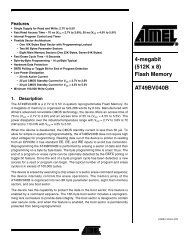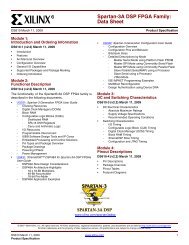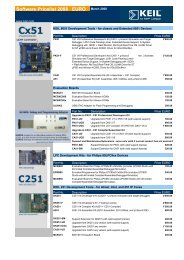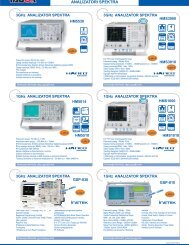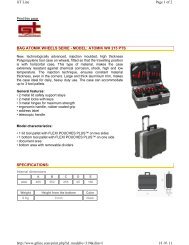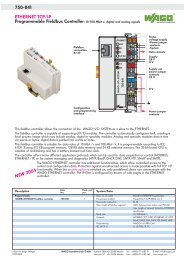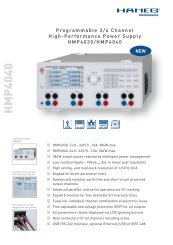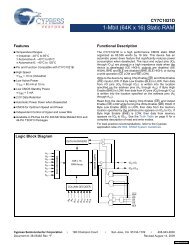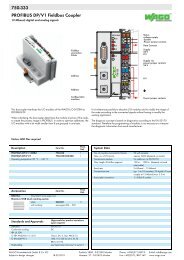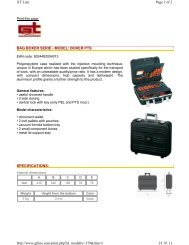PIC12F683 Data Sheet - Microchip
PIC12F683 Data Sheet - Microchip
PIC12F683 Data Sheet - Microchip
You also want an ePaper? Increase the reach of your titles
YUMPU automatically turns print PDFs into web optimized ePapers that Google loves.
<strong>PIC12F683</strong><br />
3.5.3 LFINTOSC<br />
The Low-Frequency Internal Oscillator (LFINTOSC) is<br />
an uncalibrated 31 kHz internal clock source.<br />
The output of the LFINTOSC connects to a postscaler<br />
and multiplexer (see Figure 3-1). Select 31 kHz, via<br />
software, using the IRCF bits of the OSCCON<br />
register. See Section 3.5.4 “Frequency Select Bits<br />
(IRCF)” for more information. The LFINTOSC is also the<br />
frequency for the Power-up Timer (PWRT), Watchdog<br />
Timer (WDT) and Fail-Safe Clock Monitor (FSCM).<br />
The LFINTOSC is enabled by selecting 31 kHz<br />
(IRCF bits of the OSCCON register = 000) as the<br />
system clock source (SCS bit of the OSCCON<br />
register = 1), or when any of the following are enabled:<br />
• Two-Speed Start-up IESO bit of the Configuration<br />
Word register = 1 and IRCF bits of the<br />
OSCCON register = 000<br />
• Power-up Timer (PWRT)<br />
• Watchdog Timer (WDT)<br />
• Fail-Safe Clock Monitor (FSCM)<br />
The LF Internal Oscillator (LTS) bit of the OSCCON<br />
register indicates whether the LFINTOSC is stable or<br />
not.<br />
3.5.4 FREQUENCY SELECT BITS (IRCF)<br />
The output of the 8 MHz HFINTOSC and 31 kHz<br />
LFINTOSC connects to a postscaler and multiplexer<br />
(see Figure 3-1). The Internal Oscillator Frequency<br />
Select bits IRCF of the OSCCON register select<br />
the frequency output of the internal oscillators. One of<br />
eight frequencies can be selected via software:<br />
• 8 MHz<br />
• 4 MHz (Default after Reset)<br />
• 2 MHz<br />
• 1 MHz<br />
• 500 kHz<br />
• 250 kHz<br />
• 125 kHz<br />
• 31 kHz (LFINTOSC)<br />
Note: Following any Reset, the IRCF bits of<br />
the OSCCON register are set to ‘110’ and<br />
the frequency selection is set to 4 MHz.<br />
The user can modify the IRCF bits to<br />
select a different frequency.<br />
3.5.5 HF AND LF INTOSC CLOCK<br />
SWITCH TIMING<br />
When switching between the LFINTOSC and the<br />
HFINTOSC, the new oscillator may already be shut<br />
down to save power (see Figure 3-6). If this is the case,<br />
there is a delay after the IRCF bits of the<br />
OSCCON register are modified before the frequency<br />
selection takes place. The LTS and HTS bits of the<br />
OSCCON register will reflect the current active status<br />
of the LFINTOSC and HFINTOSC oscillators. The<br />
timing of a frequency selection is as follows:<br />
1. IRCF bits of the OSCCON register are<br />
modified.<br />
2. If the new clock is shut down, a clock start-up<br />
delay is started.<br />
3. Clock switch circuitry waits for a falling edge of<br />
the current clock.<br />
4. CLKOUT is held low and the clock switch<br />
circuitry waits for a rising edge in the new clock.<br />
5. CLKOUT is now connected with the new clock.<br />
LTS and HTS bits of the OSCCON register are<br />
updated as required.<br />
6. Clock switch is complete.<br />
See Figure 3-1 for more details.<br />
If the internal oscillator speed selected is between<br />
8 MHz and 125 kHz, there is no start-up delay before<br />
the new frequency is selected. This is because the old<br />
and new frequencies are derived from the HFINTOSC<br />
via the postscaler and multiplexer.<br />
Start-up delay specifications are located in the<br />
Electrical Specifications Chapter of this data sheet,<br />
under AC Specifications (Oscillator Module).<br />
© 2007 <strong>Microchip</strong> Technology Inc. DS41211D-page 25



